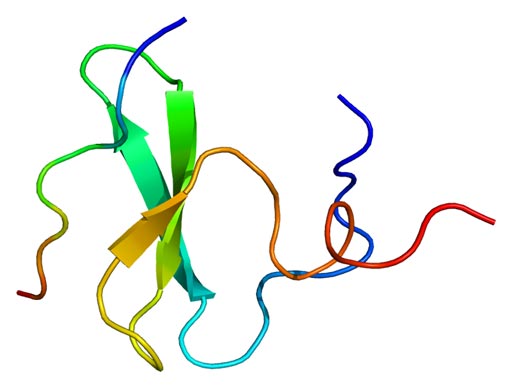Disrupted Molecular Signaling Drives Cancer Metastasis
By LabMedica International staff writers
Posted on 24 Jan 2017
A malfunction in molecular signaling that continually activates Yes-associated protein (YAP) has been linked to the ability of metastatic cancer cells to break away from the extracellular matrix (ECM) and travel throughout the body.Posted on 24 Jan 2017
In order to study the interaction between YAP and ECM, investigators at The Institute of Cancer Research had to solve the technical challenge caused by perturbations that affect cell shape and, indirectly, protein localization. To this end they developed a method using single-cell image analysis and statistical models that exploited the naturally occurring heterogeneity of cellular populations.

Image: Molecular model of YAP (Yes-associated protein) (Photo courtesy of Wikimedia Commons).
The investigators then systematically deleted 950 individual genes in cancer cell lines to identify any that influenced YAP signaling. They reported in the January 5, 2017, online edition of the journal Cell Systems that the proteins beta-PIX and PAK2, were the drivers behind both YAP activation and cell-ECM adhesion turnover during cell spreading.
To examine how YAP's activity was controlled in cancer cells, the investigators worked with cultures of triple-negative breast cancer cells that were derived either from a primary tumor or from a metastatic site. They found that if the beta-PIX pathway was disabled in cells from the primary tumor, YAP failed to activate. In contrast, in cells taken from the site of metastasis, YAP did activate. This finding indicated that invasive cancer cells sustained high levels of YAP even when not bound to the surrounding matrix.
Senior author Dr. Chris Bakal, leader of the dynamical cell systems team at The Institute of Cancer Research, said, "Our research shows how cancer cells that have become invasive are able overcome the normal constraints on cell movement. Cancer cells that have spread around the body have a switch which is jammed on - allowing them to produce a molecule called YAP all the time. This allows them to keep growing and spreading throughout the body, ignoring the physical controls that would normally stop this happening. Understanding more about the physical processes which constrain and control the growth and movement of cells can open up exciting new avenues for cancer treatment, which may have been missed until now."













